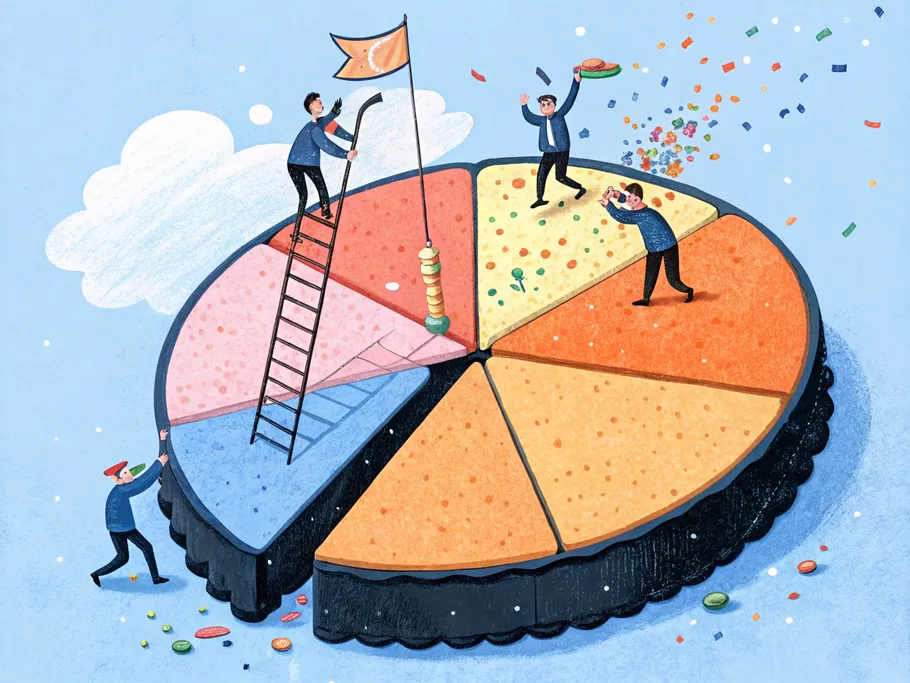How to Steal the Spotlight (And Keep Your Competitors Out Of It)
Picture this: A competitor—bigger, faster, and backed by bottomless cash—sets its sights on your market. Same product, same audience, but with the firepower to outspend, out-hire, and out-market you into irrelevance.

Think Amazon versus your indie e-commerce store. Facebook cloning Snapchat. Netflix casually torching billions while your startup clutches its last dime. What do you do?
You move. Fast. You make your product indispensable, your brand unforgettable, and your customers so loyal that no marketing blitz can lure them away.
Apple locked in users before Microsoft could dominate. Tesla set the standard before legacy automakers woke up. Nike built more than sneakers—it built a movement.
The secret to staying ahead? Act like your worst nightmare competitor is already here. Because one day, they will be. When they arrive, you should already be untouchable.
Market share isn’t just about selling more—it’s about owning your space so completely that even billion-dollar competitors struggle to push you out.
Think of: Nike (29.25% of the global footwear market) leaving Adidas and Under Armour fighting over scraps. Or Tesla (18% of the EV market) setting the pace while old-school automakers scramble to catch up. Or Google (91.86% of search) making “Bing it” sound like a joke.
More than just bragging rights, a bigger slice of the pie means:
The Perks of Being the Big Dog?
The Downsides?
Want to know where you stand? The formula is simple:
Market Share = (Your Sales ÷ Total Market Sales) × 100
Example: If your toothbrush company made $200K, and the entire toothbrush market is $500K…
(200,000 ÷ 500,000) × 100 = 40% market share
Want to see how you stack up against the biggest player? That’s relative market share:
Relative Market Share = (Your Share ÷ Biggest Competitor’s Share) × 100
Translation: If you have 15% market share and your biggest competitor has 70%, your relative market share is 21%. Time to step it up.
Here’s how to think of it: Market Share = Size. And Market Power = Control.
Owning market share is great. Owning the industry? That’s the real game.
A market leader takes sales. A market power player sets prices.
A market leader competes. A market power player makes competition irrelevant. Apple doesn’t just sell phones—it dictates the premium smartphone market. Amazon can afford to price products below cost just to wipe out competitors. Google tweaks its algorithm, and entire industries scramble overnight.
When a company reaches this level, it stops being a “price taker” and becomes a price maker—charging whatever it wants, knowing customers will still buy. That’s the ultimate flex.
The idea of a “saturated market” is as real as a unicorn doing taxes. Markets aren’t some unbreakable fortress—they exist in people’s minds. And people? They forget fast.
Think about bloggers. Every niche feels crowded, right? But compare the blogs you followed three years ago to the ones you follow now. The overlap is probably less than 20%. Some disappeared, some got boring, and new ones took their place. Consumers are the same way—distracted, forgetful, and always open to something better.
For software and other high-inertia products, switching takes longer, but the rule still applies.
So your battle isn’t about entering a “saturated” market—it’s about making your product memorable enough to stick.
The real question isn’t, Is there room for me? but rather, What will make people remember me.

Want to dominate your market? You’ve got two moves:
And how do you pull that off?
Taking down a competitor? You need one of two things:
Can’t outspend them? Outsmart them where it counts.
Too many companies tinker with their product just because. Big mistake. Before you tweak another feature, ask yourself:
“Will this market double in size over the next two years?” If yes, focus on capturing new users before your competitors do.
If not, “what will make our competitor’s customers switch to us?” If the market is steady, your goal isn’t just being better—it’s being irresistible to someone else’s audience.
Market share isn’t just about having the best product—it’s about having the best growth strategy.
Your competitors aren’t just the companies selling the same thing. They’re anything competing for your customer’s attention.
Netflix isn’t just up against Hulu and HBO—it’s battling YouTube, TikTok, and even the decision to read a book instead. Starbucks isn’t just competing with Dunkin’; it’s fighting the choice to make coffee at home.
True competition happens inside the customer’s mind, not just in market share reports. If you don’t understand how customers make decisions, you’ll never know who your real rivals are.
The biggest players don’t just have the best product—they shape how customers think. The companies that dominate don’t just compete in an industry; they redefine it.
Your job isn’t just to fight for space in a market—it’s to make your product the only logical choice. And if you do that? You won’t just win market share. You’ll own it.
Owning the biggest slice of the pie is great, but how you control that slice is what really counts. Market share isn’t just one number—it comes in three key flavors:
Coca-Cola and Pepsi might be neck and neck in market share, but Coke dominates the wallet share thanks to cult-like brand loyalty. Apple doesn’t need to sell the most phones—just the most expensive ones. Nike? It owns share of voice so thoroughly that “sports” basically means “swoosh.”
Looking at total market share alone is like judging a movie’s success by ticket sales without checking its budget. More sales ≠ more control. If the industry is booming, even record-breaking growth might still mean a shrinking market slice.
A massive marketing budget doesn’t guarantee dominance. Share of voice is useless if people aren’t actually buying. Profitability isn’t about volume. Airlines dominate travel but survive on razor-thin margins. That’s why Hermès sells far fewer bags than Zara but makes a fortune on exclusivity.
In thinking about how to increase market share for startups, as well as about the impact of market share on profitability, it helps to remember: some giants burn cash just to maintain dominance, while niche players rake in profits by charging a premium.
Tesla sells fewer cars than Toyota but enjoys higher margins. Walmart competes on volume, but Louis Vuitton thrives on scarcity and premium pricing.
The lesson? Growth without profitability is just an expensive ego trip.

Not all markets play fair—some are open battlefields, others are tightly controlled clubs. The structure of a market determines how much power a company can exert:
Too much control isn’t just bad for competitors—it’s bad for consumers.
Giants flex their muscles in ways that make even Bond villains take notes:
At the end of the day, market share is a game of strategy, not just size. Whether you’re chasing dominance, profitability, or survival, knowing how you win is just as important as winning itself.
When a market is crowded, standing out isn’t about shouting louder—it’s about knowing where to stand. The strongest brands win by playing to their strengths in four key areas:
Not sure where your brand fits? The BCG Matrix is a go-to tool for assessing your product lineup—helping you decide where to double down or cut your losses.
Screaming, “We’re better!” isn’t a strategy—everyone claims that. A real Unique Value Proposition (UVP) gives customers a clear, compelling reason to choose you over the rest.
Airbnb: “Live like a local.” More than just a place to stay—an experience.
Tesla: “The future of driving.” Not just electric, but revolutionary.
Dollar Shave Club: “Shave time. Shave money.” Simple, punchy, and impossible to forget.
If your market is packed, find the gap your competitors ignore. If they’re obsessed with luxury, go budget. If they offer variety, specialize. Carve out a niche that feels like an upgrade, not just another option.
Market dominance isn’t just about competition—it’s about context. Trade wars, supply chain disruptions, and economic sanctions can shift the playing field overnight.
Huawei lost major markets when U.S. sanctions cut off chip supplies.
McDonald’s exited Russia—only to have a near-identical clone (Vkusno & Tochka) take its place.
Apple saw the risks of over-reliance on China and shifted production to India and Vietnam.
The key? Diversification. Companies that adapt survive. Those that don’t? They get blindsided. Want a deeper dive? Porter’s Diamond Model explains how a country’s economic and regulatory landscape shapes which companies win globally.
Market share is a tool, and market leadership isn’t luck—it’s strategy. The best brands don’t just compete; they fortify their position.
You may get a first-mover advantage, but staying on top demands constant reinvention. Customers forget, new players emerge, and so the only way to win is to be the brand they can’t ignore.

Email subscription is available ONLY TODAY (oh, okay, and tomorrow).
Surely, we respect your inbox! Unsubscription works every day.

We’d love to tailor your experience — which of these best describes you?